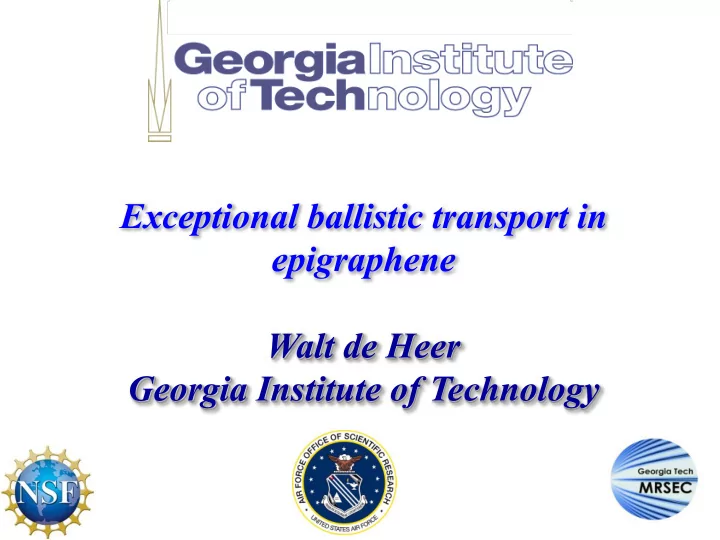

Exceptional ballistic transport in epigraphene Walt de Heer Georgia Institute of Technology
Program Objective First formulated in 2001 and patented in 2003, our objective is to develop nanoelectronics based on epitaxial graphene on silicon carbide. Sprinkle et al. Nature Nano, vol. 5, pp. 727-731,. 2010
Si wafer Si nanoelectronics Si crystal 200 GHz epitaxial graphene transistor (GaTech) SiC wafer Intel funded the GIT Graphene project in 2003 3
Epitaxial graphene, by the CCS method reviewed in PNAS 108, 16900 (2011) Epitaxial graphene produced by vacuum sublimation of Si from electronics grade SiC. pleat Atomically flat 0.05 nm 0.5 nm 50 nm STM First CCS Induction (Courtesy J. Stroscio) Furnace 400 nm (2004) The graphene sheet continuously covers the entire surface. Its major disadvantage is, that it cannot be back gated.
Important achievements • Record breaking high- speed analog FETs. • Demonstration of high quality semiconducting epigraphene and related FETs. • Demonstration of novel spintronic devices. • Record breaking room temperature exceptional (not understood) single channel ballistic transport, involving new physics. graphene graphene G D S Gate Gate SiC Source Source Drain 1µm
Exfoliated graphene nanoribbons have transport gaps This realization essentially ended exfoliated nanoelectronics research! “Edge disorder” Transport gap (not a band-gap)
Ribbons as waveguides c * ≈ 10 6 m/s for W=40 nm and L=1 µm Caveat: E 1,0 /k B =600 K, Micron length graphene ribbons E 0,1 /k B =23 K, are quantum dots!
Structured graphene growth on sidewalls Selective growth on sidewalls etched into SiC Avoids disorder at edges Preferential graphene growth Photo-lithography defined Ni mask on the recrystallized (1-10n) facets Plasma etched SiC step ~1500C, 10 min Graphene ribbon Graphene grows rapidly on substrate steps and sidewalls. The sidewall first re-crystallizes (facets) and then graphitizes M.Sprinkle, Nature Nano 2010
High device density Scalable method M.Sprinkle, Nature Nano 2010 More than 10,000 FETs per chip (6 x 4 mm 2 )
STM - STS: graphene on side wall - buffer on Si-face Antonio Tejeda, Muriel Sicot, CNRS, France 27° 0.1 dI/dV (arb.units) dI/dV (arb.units) dI/dV (arb.units) S 0 Sample bias (V) Sample bias (V) Sample bias (V)
Ribbons and beyond: Structured graphene
Exceptional Room temperature Ballistic Transport in Epitaxial Graphene Nanoribbons . ( Nature 506, 349, 2014)
Multiprobe, in-situ transport measurements Omicron nanoprobe system (Tegenkamp group Hannover) SEM image of 4 probes positioned on a sidewall ribbon Outer probes supplying a current. Inner probes measure potential.
Multiprobe, in-situ transport measurements 3 l (µm) 4.2 2 R 4pp (h/e 2 ) 16 28 1 58 (-100) 0 0 1 2 3 4 5 Inner probe spacing L(µm) F our-point (R4pt) and two-point (R2pt) resistances as a function of probe spacing L.
Room temperature resisitivies and mobilities How to determine resistivity unambiguously 10 2 10 3 10 4 Length 10 3 Sheet resistance ( W ) Mobility (cm 2 V -1 s -1 ) Resistivity (µ W -cm) 10 2 R = r Width . Thickness 10 3 10 4 r = ¶ R Typical 2D exfoliated 10 1 ¶ L W . T 10 2 10 5 10 0 Theoretical limit Measuring dR/dL 10 1 10 6 eliminates contact 10 -1 resistances 10 0 10 7 10 -2 3 10 100 1000 Ribbon width (nm) R 4pp (h/e 2 ) 2 1 0 0 1 2 3 4 5 Inner probe spacing L(µm)
Ribbon conductance versus probe spacing and temperature Two channels (0+, 0-) 0- turns off One channel (0+) 0+ turns off 17 µm L 0 =200 nm G=1+ exp(-T/T 0 ) (L≤L 0 ) G=1+ exp(1-L/L 0 ) exp(-T/T 0 ) (L>L 0 ) T 0 =hc*/k B L The 0- mode is the lowest longitudinal excitation of the ribbon, i.e. the n=0, m=1 state
Longitudinal excitations of quasi particles n=0, m=1 E 0,1 =hc*/2L E 0,0 =0 n=0, m=0 • What are the quasi particles? • They are Fermions and appear to have large magnetic moments. • They seem to have finite, temperature independent lifetimes! • Could they be composite particles (charged excitons)?
Summary Transport in neutral epigraphene nanostructures is exceptional, with no counterpart in any other material system. A new kind of quasiparticle is involved whose properties are ideal for a new form of electronics.
- L (µm) G (2e 2 /h) Nanotube fiber L V Conductance is ballistic at room temperature. G≈G 0 =2e 2 /h (≈1/13k W ). Theoretically it should be 2G 0 Current densities exceeding 10,000 µA/µm are sustained
Recommend
More recommend